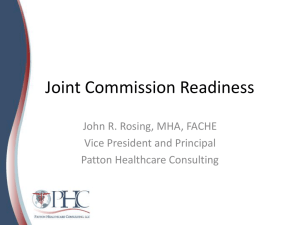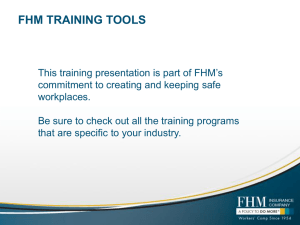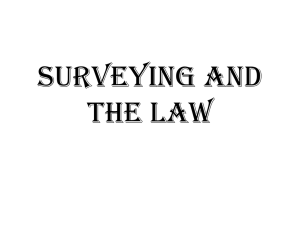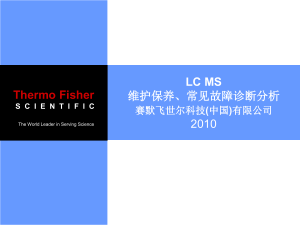top 10 most frequently scored standards
advertisement
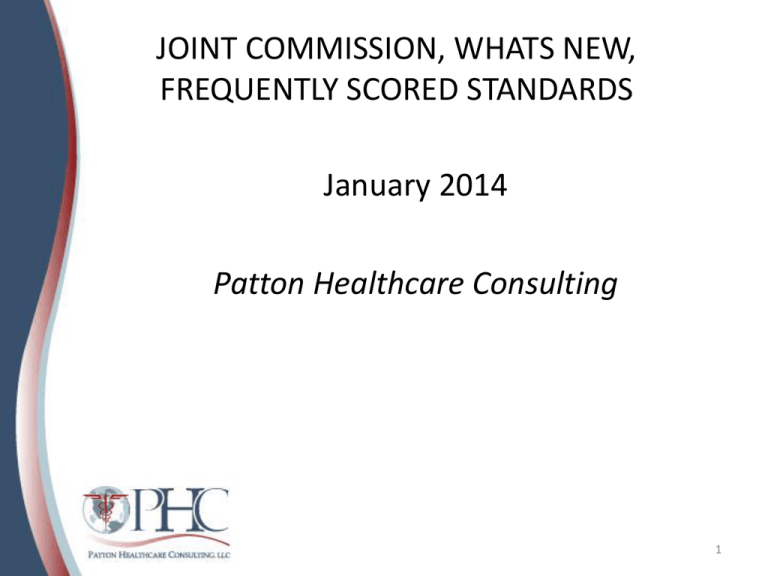
JOINT COMMISSION, WHATS NEW, FREQUENTLY SCORED STANDARDS January 2014 Patton Healthcare Consulting 1 CURRENT NEW DIRECTIONS AND THEMES • • • • • • • EC/LS heavily focused and scored High level disinfection OR temperature and humidity Air handling and pressure relationships MS.01.01.01 gaps Contract management Closed record review to zero in on restraint issues and ICU sedation issues • Then there are the top 10 2 New Focus • High Reliability Organization 3 GOOD IDEAS FOR TRACER INTERVIEW • Be enthusiastic about how good you are • Talk proudly about the excellent service and care you provide • Offer data or other follow up to support compliance if available for areas cited by surveyor • Have multiple staff (MD, pharmacist plus RN a BIG help) participate in the unit interviews, one person can forget, get intimidated • Know what your EMR will display based on userid. • Don’t think “what is the right answer” think about what you do day after day. • Know where policies are kept & how to access them 4 When They Are on Your Unit • Know where to find your policies & “fast facts” or other tip tool • Have two people in the patient record, a second person as back up looking for stuff • Offer policies, describe education • Use your resources, you don’t need to memorize • Call on experts around you 5 When They Leave… • After the team leaves, find all “IOUs” • Find the order • Find the anesthesia record, the consent, etc • Copy it, highlight the part the surveyor couldn’t find • Find the surveyor, show them AND/OR • Bring a copy to the surveyor room during special issue resolution, escort should record this 6 Role of the Escort/Note Taker • With an electronic system consider a buddy system, have someone other than the nurse search the record for requested information • Gently coach • Record offers to present support and record surveyor’s response • Record the “he said” “she said” • Record MR numbers 7 GOOD IDEAS FOR TRACER INTERVIEW • In the PACU or PreOp holding know that your surveyor is going to want to see: – – – – – – – – – History and physical Update to the H&P Nursing assessment Consults Orders Home medication list, reconciliation if inpatient If surgical, pre anesthesia 1+2, time out, Post procedure note with all elements post anesthesia note. • Train escorts and scribes where to find these. 8 Tracer Tips For Staff • Before answering a question: – Take a deep breath – Make sure you understand the question – Or ask “Could you please rephrase that question…” – Offer to provide the answer later in the day – Stop talking once you have answered – If your surveyor pauses after your answer, try to seek acknowledgement that you have fully answered the question don’t just restart talking. 9 Tracer Tips For Staff, cont. • Never, never “fix” a chart to avoid an RFI • Never “make up” answers to please the surveyor • Don’t be intimidated by surveyors, or by your own management. • Do not argue with the surveyor • Take advantage of surveyor suggestions • Know what improvements in patient care came from PI (performance improvement) activities • Don’t affirm the leading question…” this isn’t a very good process, is it?” 10 Focus on the Top 10 & NPSGs • The 2014 standards have 1700 EPs that can be scored • The Joint Commission does >90% of its scoring on about 25 standards/NPSGs • Implement the top scored and all NPSGs • Spend you dollar here! 11 The Top 10 Most Frequently Cited TJC Standards 2013 1. Medical Record Entries RC.01.01.01 EP 6, EP 11, EP 19 55% – Information needed to justify the patient’s care, treatment, and services missing – Entries are not dated, timed, signed – Illegible hand writing 12 The Top 10 2. Maintaining the Path of Egress LS.02.01.20 EP 13, 16-22 54% – Corridors are not free of clutter – Exit door, exit sign – Suites are not designated and maintained 13 Top 10 3. High Level Disinfectant IC.02.02.01 47% – – – – – EP 1, EP 2, EP 4 High level disinfection and sterilization problems Staff competency and staff supervision are focus areas Poor low level disinfection – Ø contact time Poor storage of equipment, devices, and supplies Has resulted in Immediate Threat to Life and/or Condition Level Finding 14 Top 10 4. Manage risks with Ventilation systems EC.02.05.01 46% – Will lead to a Condition Level Finding – New to the top 10 in 2012, scored in the ORs & procedure areas – Pos/Neg air pressure relationships – Air exchanges, correct # per hour – Filtration problems • Surveyors can use Tissue Test • Improper system design, or • Lack of inspection, testing, maintenance or performance problems 15 Top 10 5. Maintain building features to prevent effects of fire, smoke LS.02.01.10 45% – Penetrations in fire barriers and fire door issues are still a problem. – Usually fire doors not latching – Doors undercut, gaps, rated 16 Top 10 6. Maintenance of Fire Safety Equipment EC.02.03.05 EPs 1- 25 44% – Inspection, testing and maintenance of each piece of fire safety device (smoke detector, fire pull station, magnetic door release) – Documentation in not readily available for testing fire safety equipment – Often a double hit against leadership 17 Top 10 7. Maintain building features to protect against fire and smoke LS.02.01.30 43% – Primary issue is doors to hazardous areas that are propped open – Smoke barrier penetrations, hazardous areas not protected – Gaps under doors 18 Top 10 8. Maintain fire extinguishing features – – – – LS.02.01.35 35% Sprinkler or fire extinguishment issues Hanging things from sprinkler pipe, 18 inch rule, sprinkler head broken Also, scored here: ventilation, temperature and humidity problems. 19 Top 10 9. Safe, functional environment EC.02.06.01 EP 1, EP 13 36% – Safe, functional area, a catch all standard for ripped mattresses or stained ceiling tiles – Maintain ventilation, temperature and humidity • Door held open by air pressure, hot/cold calls, humidity >60%RF • Also scored here: storage of oxygen cylinders 20 Top 10 10.Safe medication storage MM.03.01.01 EPs 2, 3, 6, 7, 8 33% – Unsafe/secure storage of medication – Refrigerator temperature not sustained/monitored – Meds unsecured – not locked or under constant surveillance – Access by non-licensed is not approved by policy – Terminated employee ADM access is not cut off – Improperly labeled including Ø beyond-use date – Expired or damaged are not removed 21 And the Runner-Ups 11) EC.02.02.01 EP 3 & 5. Hazardous materials and eye wash station testing 12) PC.01.03.01 - care plan can be interdisciplinary and customized. 13) MM.04.01.01 - EP 13 Implementation of medication orders. 14) EC.02.05.07 - Generator testing is not done on time, or for long enough. 15) EC.02.05.09 - Problems with medical gas systems. 22 And the Runner-Ups 16) HR.01.02.05 - This standard made it back on the top 20 list! Primary source verification. 17) PC.01.02.03 - EP 5 The most frequent problem is the update to the H&P. 18) EC.02.03.01 – This standard is a catch all for fire safety issues. 19) MS.01.01.01 – The biggest issue is that the requirement for completing the H&P is not specified in the medical staff bylaw.s 20) PC.03.01.03 - The requirement for the preanesthesia and pre-sedation assessments 23 Success Strategies: Survey Checklist Keep policies simple Mock Tracers to check compliance Fix it or find another way Focus on the top 10 & NPSGs Bullet proof weak areas Avoid the Situational Rules 24 STANDARDS THAT BECOME MORE CHALLENGING WITHassessment” EMR • “Find me the pre-anesthesia • “Show me the immediate reassessment just prior to induction” • “Show me the immediate post procedure note” • “Show me the documentation of time out” • EMR will date and time these notes automatically so audit and evaluate how your records look. • Make sure staff can even find these documents 25 EMR AND TIMING • • • • • • • • • 6:30 am, patient arrives, IV started H+P update 7 am Pre-anesthesia assessment 7:15 am Pre-procedure medication orders and IV by anesthesia written at 7:30 Pre-procedural verification by staff 7:45 Time out 7:55 Anesthesia record case ends 10 am Immediate post procedure note timed 7:30 Post procedure orders timed 7:30 26 EMR AND TIMING • If you want to start post procedure notes prior to the case filling out demographic, diagnostic information, make sure the note has a final time documented electronically or by author. • If you want to write post procedure medication orders, there must be a process to pend, and unpend them which includes physician authorization 27 WHAT REALLY ARE THE H+P REQUIREMENTS? • • • • Done within 24 hours of inpatient admission Done before surgery or invasive procedure Follows your bylaws, R+R content expectations If done in the community it can be updated if less than or equal to 30 days old • Update note must state: “I have examined the patient, I have reviewed the H+P and there are/are not changes except as noted”. 28 WHAT ELSE SHOULD I WORRY ABOUT? 29 Alarm Fatigue Focus Issue • A sentinel event alert was released in April ’13 • Focus of a new National Patient Safety Goal for 2014 • Alarms have led to Immediate Threat – – – – Alarm being shut off or silenced Not resetting alarm after silenced Not trained on all equipment Result in patient death 30 Sentinel Event Alert Recommendations ① Leaders ensure there is a process for safe alarm management and response in highrisk areas. ② Prepare an inventory of alarm-equipped medical devices and identify the default alarm settings and appropriate alarm limits. 31 Sentinel Event Alert Recommendations ③ Establish guidelines for alarm settings. Define when alarms are not clinically necessary ④ Establish guidelines for tailoring alarm settings and limits for individual patients (who can modify and when) ⑤ Implement routine inspections and maintenance of alarm-equipped devices. ⑥ Staff training on above 32 Sentinel Event Alert Recommendations ⑦ Adhere to manufacturer instruction for use, eg: replace single use leads, replace batteries ⑧ Assess acoustics of alarm sounds ⑨ Set as a leadership priority ⑩ Establish a team to address 33 New NPSG on Alarm Safety NPSG.06.01.01 1 Establish alarm safety as a priority (7/2014) 2 Identify the most important alarm signals to manage (2014) 3 Establish policies and procedures for managing clinical alarms. (1/2016) 4 educate staff and LIP’s about the purpose and proper operation of alarm systems (1/2016) 34 HIGH LEVEL DISINFECTION • Identify every location performing HLD and make sure you have a standardized process. • Visit every location performing HLD and make sure staff can precisely verbalize the process including dilutions, soak times, dating of chemicals, dating of test strips, documentation of testing. • Make sure there is adequate separation of clean and dirty activities. • Make sure scopes can hang freely, not touching the bottom, not looping • Close the scope storage cabinet 35 HIGH LEVEL DISINFECTION • Laryngoscopes, after HLD, must stay wrapped • ET tubes, and stylets, purchased or cleaned must stay wrapped • If you open a package for a case, discard the device or send for repeat cleaning and wrapping at the end of the case. • If you use a blade to test a laryngoscope, there must be a process to keep it clean. • Keep airway circuits wrapped, clean until ready for use 36 HIGH LEVEL DISINFECTION • The endoscopy scope cleaning room should be under negative pressure to remove contaminants and Cidex or other vapors • In endoscopy, the decontamination door is to stay closed so that the negative pressure can work. • The endoscopy procedural area should be under positive pressure to avoid contaminants leaking in. • If you have new space for bronchoscopy, it should be under negative pressure. • Obtain copies of your pressure reports to verify 37 HIGH LEVEL DISINFECTION • Surveyors will observe staff as they process dirty equipment • Surveyors will check manufacturer instructions for use (IFU) for three things: the device/instrument, the sterilizer itself, and the packaging (i.e., blue wrap or flash pan.) • Check your policy, check staff understand and follow both. Create a recipe book • Will observe proper use of PPE 38 OR TEMP AND HUMIDITY • There should be a process to measure and record daily. • Can be building automation or staff performed. • Humidity expectation is below 60% (mold and bacteria concern) and has been greater than 35%, but CMS has just authorized greater than or equal to 20% (fire hazard concern) • See S&C 13-25 4/19/13, must document use of their blanket waiver on low humidity 39 AIR HANDLING AND PRESSURE RELATIONSHIPS • OR’s, CSR, Endo, decontam, isolation rooms • Surveyors will perform tissue tests, a crude approximation of air pressure relationship. • Based on observations they will ask for your validated report. • Many organizations have: – Not performed the test – Can’t find the test – The test failed, and no correction – The test is old and the relationship no longer works 40 MS.01.01.01 • Required implementation April 2011 • Open book test, no performance requirement • All you had to do is place required statements in medical staff bylaws and rules and regs • Many organizations ignored the differentiation between bylaws and R+R. • Bylaws are hard to change • R+R and somewhat easier • Tab a copy of your bylaws with EP’s 16-36 identified – If gaps noticed, go back and add the content 41 CONTRACT MANAGEMENT • LD.04.03.09 clinical contracts must be identified and a list provided to your surveyor • Each contract must have: – Performance expectations – Performance evaluation – Input from senior leadership/MS • Surveyors will pick one or more of your contracts from you list • Challenge is being able to identify them all – People who perform patient care, clinical services that would otherwise be performed by an employed healthcare professional 42 CONTRACTS OFTEN MISSED • Off site pharmacy compounding in a licensed pharmacy (remember NECC) • Nuclear isotope compounding in a licensed pharmacy • Pacemaker interrogation by contractor • Custom orthotic fittings requested and paid for by the hospital • Physician leaders, telemedicine contractor, anesthesia group, ED group 43 CLOSED RECORD REVIEW • When surveyors perform tracers, they see patients that your currently have • They may miss the opportunity to see a restraint patient, an ICU sedation patient, an insulin sliding scale or drip patient, and anticoagulation adjustment patient, a blood transfusion, a death, an ED transfer out, a circumcision. • Closed record review opens up all of these • Must be able to find these types of records 44 PLANS OF CARE • • • • Review the H+P Review the initial nursing assessment Identify care issues to manage Does the read of the care plan sound like the same patient you read about in H+P or initial nursing assessment? • Must update care plan immediately if placed in restraint. 45 MEDICAL GASES • Staff can’t park anything in front of the gas shut off valve • Valve must be labeled correctly with room numbers • Nursing staff must know what to do in the event of a fire • Engineering staff must have an inspection report on proper functioning – Defects noted in the report must be corrected and the report annotated 46 PAIN REASSESSMENT • We perform pain reassessment at the required intervals • We perform pain reassessment within X minutes of giving a pain med – Try to keep it simple • Document the reassessment, be careful in EMR as it may document failure if the note is late – Consider late note process if using a flow sheet to document. If end of shift note is permissible, not necessary. 47 Patient Flow New Standards for 2013/2014 • Revisions to Standards – LD.04.03.11 – hospital manages the flow – PC.01.01.01 – Hospital meets the needs of the patient • Perspectives July, 2012 • A new R3 document was published • Another addition planned for 2014 re boarded patients 48 Patient Flow New Standards for 2013/2014 • LD.04.03.11 – hospital manages the flow – Leaders use data – Manage throughput – Not just ED, this include PACU – Behavioral Health communication (Jan 2014) • PC.01.01.01 – focus on BHC boarded patients – Staff training – Environment safe and suited – Patient assessment, policies, community 49 BEHAVIORAL HEALTHCARE • 37% CTS.03.01.03 Treatment planning reflect assessed needs, strengths, preferences and goals • 23% HR.02.01.03 LIP privileges or clinical responsibilities • 15% CTS.02.01.05** For non 24 hour settings: process for a requiring a medical history and physical • 15% HR.01.06.01 Competency assessment for staff • 15% NPSG.15.01.01 Suicide screen • 14% EC.02.06.01 Safe, functional environment 50 BEHAVIORAL HEALTHCARE • 13% HR.01.02.05 ** The organization verifies staff qualifications • 10% MM.03.01.01 Medication storage • 13% CTS.04.03.33 Food sanitation/storage • 13% CTS.02.01.11 Nutritional screen • 11% CTS.02.01.09 Pain screen (‘12) • 11% RC.01.01.01 Legibility (‘12) 51 QUESTIONS? • Kurt Patton – Kurt@PattonHC.com • Jennifer Cowel – JenCowel@PattonHC.com • John Rosing – JohnRosing@PattonHC.com • Mary Cesare Murphy – MCM@PattonHC.com 52



